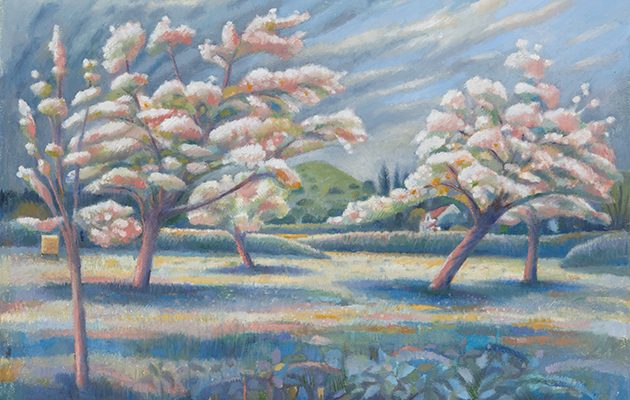The landscapes and farming practices of the Somerset Levels have influenced Kate Lynch’s art, as she explains to Janet Menzies
Inspired by the families working and living on the Somerset Levels, Kate Lynch paints contemporary, peopled landscapes. She explains to Janet Menzies how her work has allowed her to feel fully in touch with rural England.
For more sporting artists, the sculptures by Paul Jenkins perfectly encapsulates the madness and mischief of hares, and now he is adding foxes to his repertoire. And the greats would approve of Sophie Harden, who is inspired by her days out with the Pytchley.
KATE LYNCH
Many artists only truly find their art when they have found their subject. This has certainly been the case for Kate Lynch, who explains: “I had been living in Somerset for many years and painting landscapes and studying life drawing at Bristol School of Art, but then we moved to the Somerset Levels and I saw that it was such a different kind of place with such different farming practices. There were little trailers loaded with apples. And small tractors. I was interested in all the stories going on in the landscape. I started talking to people and trying to paint them. I heard about the cider making and it seemed to draw me to go and ask what people were doing. They were so welcoming and so I would sit and make drawings of them working and they would tell me their stories.”

Rob feeding the sow and piglets.
The result is an evocative body of work with titles including: Rob feeding the sow and piglets, Glebe Farm; The Lockyer family pressing apples for cider; and Jack tying stripped willow to dry. The inclusion of specific names in the titles is deliberate. These are contemporary, peopled landscapes. Lynch says: “The paintings are a tribute to the people. They are celebrating the life of that person. I want it to be about them – I want them to recognise themselves.” This began for Lynch when she became beguiled by the paradox of life on the Levels. The rural economy of the area has developed over many generations in a way that is glibly described as a ‘bygone era’, yet it is thriving, with many of its products in demand and on the shelves of trendy urban foodhalls.

The Lockyer family pressing apples for cider.
As she began to join in with Levels life and help with the work, Lynch discovered that while it may be traditional, there’s nothing ‘bygone’ about it. She insists: “I have never felt that I am catching something before it goes. I have just been getting to know the people and documenting them working the land. I have been meeting people who have been doing it for generations and still are doing it. The families are continuing a tradition – a living tradition.
LOCAL PEOPLE
“At the time I did the willow growers I thought, I am really lucky to see this and I am catching these old basket-makers. But with the shepherds and the beekeepers and the farmers I have not felt that. When I was with the willow growers they were talking to me about willows in the war, and the stories went into the sketch book and it was story time and painting time. So I was really happy that their stories got mixed in and I started to record conversations. It was a very happy thing to find such an environment filled with people who knew the place. The local farmer said, ‘What are you going to do next?’ I didn’t know anything about sheep and John Vigor invited me to come out raddling – and I have been taken out by people who are so welcoming. I climb into the Land Rover with them and make drawings about it.”

Jack tying stripped willow to dry.
It was natural for Lynch to develop this work into books that combine illustration and narrative, including her 2017 publication, Farm. Her projects with schoolchildren are also important to her and the Somerset Rural Life Museum at Glastonbury exhibits a painting with Elmhurst Junior School of Abbey Farm, Glastonbury. Lynch explains: “When I have shown my work previously the words have been an integral part of it.” The stories behind each painting are fascinating, like that of Mr Bryne digging, 4th May. “I passed a man digging along the rhine and I stopped and watched him and talked and made a painting of him digging. And I said, ‘Why are you digging?’ He said, ‘Well, I have always dug. In my father’s time it was garden and if I don’t dig it will disappear.’”
That was Mr Byrne, and rhine is the Levels term for the ditches that criss-cross the area, draining what was once an inland sea surrounding Glastonbury Tor and inspiring much mythology. Where fantastists see Avalon and mystic crystals, Lynch finds people working hard and building authentic lives. Instead of imposing an outsider’s idea of theme park countryside, Lynch has entered its real world. She says: “For somebody who did not grow up in rural England, I feel that I am in touch with it now. When I was a child in the London suburbs, this was all going on here, then as now. There’s a continuity which doesn’t exist in the city.”
The Kate Lynch exhibition, Changing Seasons, is at the Jerram Gallery, Sherborne, Dorset, until 1 May, Tuesday to Saturday: tel 01935 815261; www.jerramgallery.com. To discover more about her work, go to: www.katelynch.co.uk





